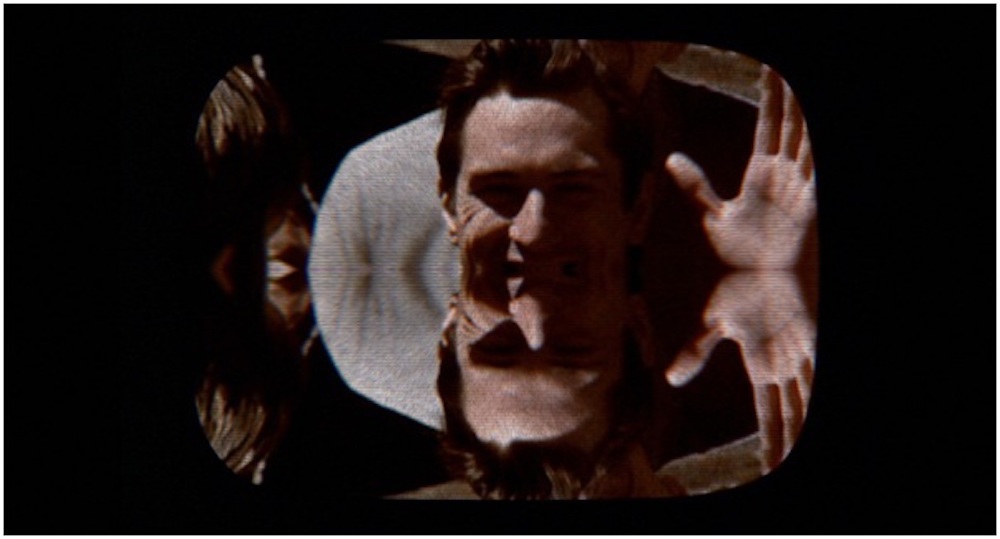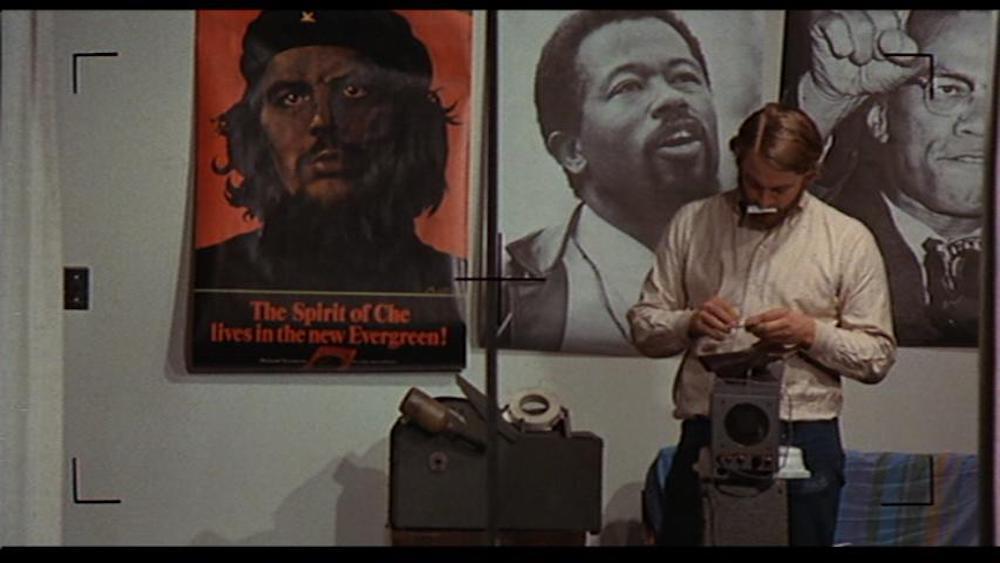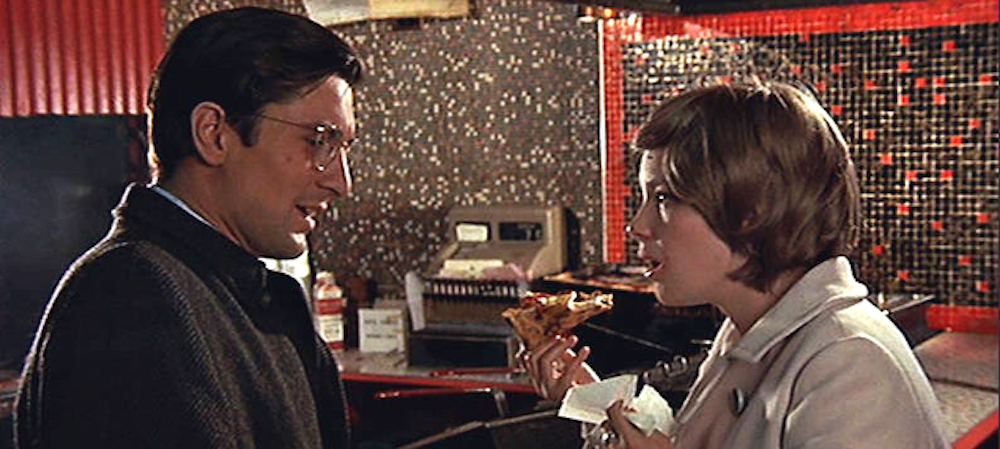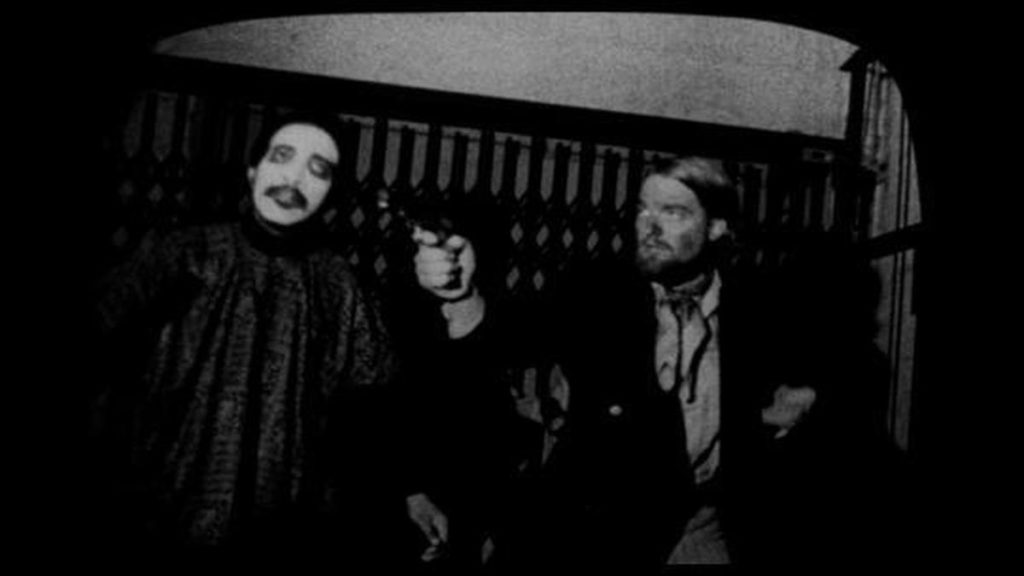| Courtney Kowalke |

Hi, Mom! plays at the Trylon Cinema from Friday, November 3rd, through Sunday, November 5th. Visit trylon.org for tickets and more information.
I cannot escape the reach of Ancient Greek theater. The last piece I wrote for Perisphere was about Mai Zetterling’s The Girls and a fictional production of Aristophanes’ comedy Lysistrata. It turns out a large part of director Brian DePalma’s inspiration for his 1970 film Hi, Mom! was the stage play Dionysus in ’69—an adaptation of the Greek tragedy The Bacchae by Euripides.1 Along with Bruce Joel Rubin and Robert Fiore, De Palma was responsible for filming the show’s final two performances and combining them into a motion picture released the same year as Hi, Mom! Quote Wikipedia, “Dionysus in 69 was an example of [play director Richard] Schechner’s practice of site-specific theatre, utilizing space and the audience in such ways as to bring them in close contact with each other.”2 De Palma has cited this experience as direct inspiration for the Be Black, Baby! section of Hi, Mom! Professional actors making the audience part of the show without forewarning is the main conceit of Be Black, Baby!, and its reversal of spectators becoming the spectated is a thin undercurrent through all of Hi, Mom!’s meandering plot.
Hi, Mom! starts out as a sequel to De Palma’s 1968 black comedy/satire Greetings. Greetings isn’t required viewing, however, because the only main returning character is Robert De Niro’s Jon Rubin. Greetings is about Rubin trying and failing to dodge the draft; Hi, Mom! follows Rubin after he returns from Vietnam.
Rubin is an unabashed pervert. A purveyor of ‘peep art’ in Greetings, Hi, Mom! starts with Rubin finding an investor and launching a service to film his neighbors at an apartment co-op without their knowledge or consent. By doing this, Rubin hopes to make pornographic films he can sell. At the risk of sounding like a pervert myself, this plot bears surprisingly little fruit. Aside from a few pairs of naked breasts and a full-frontal shot of Gerrit Wood (Gerrit Graham), Rubin’s neighbors keep what goes on behind closed curtains, well, behind closed curtains. Rubin gets frustrated and seduces his neighbor, Judy (Jennifer Salt), just to get some action, but even then, his camera malfunctions. Nobody ever has sex on-screen in Hi, Mom!.

Filmmaking and voyeurism go hand-in-hand. A character on screen watching people without their knowledge can be an easy stand-in for a person sitting in a dark theater watching that character without the character’s knowledge. Movie-goers can watch and judge the plot from a safe vantage point while participating in the movie character’s exploits, like voyeurs do.
When I first pitched this article to Perisphere, I intended to look at Hi, Mom!’s narrative use of voyeurism and draw comparisons to how surveilled our society is today. We live in a land of security cameras and cell phones with filming capabilities. You can’t go on social media without tripping over videos people have taken and posted of strangers without their knowledge. Anyone can document whoever they choose regardless of time or place nowadays.
Hi, Mom! didn’t actually give me a lot to work with in that respect. We get two or three undercranked montages of Rubin filming his neighbors, and nothing really comes of it. We get a little rom-com detour with Rubin seducing Judy, and nothing really comes of that either. I did find some of these scenes funny; the bit where Rubin has to go to a pharmacy to buy condoms in particular made me laugh out loud. That said, it can be hard to care about fictional characters who don’t have goals or, in Rubin’s case, don’t achieve their goals. We the audience watch Rubin watch people, but it isn’t interesting or insightful in any way.

Image sourced from Trailersfromhell
Then, of course, we get Be Black, Baby!. After failing to make porn, Rubin joins an experimental theatre troupe, most of whom are African-American. They’re staging a show for a group of affluent white people. Billed as an evening to experience life as a Black person, the show starts with the white people feeling up the Black actors like livestock. The audience is taught some dance moves and fed some soul food. Then the actors bring out the shoe polish to paint the theatergoers’ faces black. One of the actors, Carolyn (Carolyn Craven) takes off with one of the white women’s purses. Another man finds his wallet suddenly empty. A member of the audience goes into a back room to ask the troupe about this and gets beaten up behind closed doors.
The Black actors reappear with their faces painted white and brandishing guns. Now, to really make their white audience understand being Black, the actors herd their audience upstairs where more physical violence ensues, more racial slurs get thrown around, and one woman gets stripped naked at best and sexually assaulted at worst (I thought the framing of the scene made it unclear). The play ends with Rubin as a police officer showing the white theatergoers some good old-fashioned racial profiling before throwing them out onto the street.
Once the shock has worn off, though, Be Black, Baby! is as shallow as everything that came before it. I read entirely too many articles in preparation for this piece, and the general consensus is that the Be Black, Baby!’s point is to mock the affluent white people who talk about supporting the Black community but don’t want to interact with Black people. The white people and their discomfort is the point of ridicule.
I don’t know if I would have gotten that from only watching the movie, though. Why did De Palma choose to address the issue of racial inequality and white savior complexes in the way that he did? Why did he think that was the most effective way to make his statement?
A boring truth is that satire requires a consideration of ethics. Much like comedy is concerned with timing and pacing a joke so it lands at exactly the right moment, satire is about threading the needle of highlighting societal issues without moralizing while also (hopefully) being funny. Satire is more of an approach to telling a story than a genre, and according to Poe’s Law, “without a clear indicator of the author’s intent, any parodic or sarcastic expression of extreme views can be mistaken by some readers for a sincere expression of those views.”3 Satire needs a clear focus to work, in other words. Be Black, Baby! feels like something De Palma did just because it was outrageous and because he could.
Who is the audience for Be Black, Baby!? The white people are not in the right—earlier on, one of the white women pulls out that old chestnut, “I don’t care if you’re green, blue, yellow…” when asked if she discriminates against Black people. They talk the talk, but it’s lip service. At the end of the night, they brush off what they experienced in the theater and go back to their lives of privilege.
If it’s for Black people to feel seen and to get catharsis, then why make them violent, thieving rapists? You could make the argument that those are only their white personas. You could argue that they wield power in the way that it’s modeled for them by American society, in the way white people assert their dominance over racial minorities with systemic violence.
You could argue that both sides are supposed to be unsympathetic. I don’t think that works because there’s a large and complex history of white people oppressing Black people for baseless reasons in the United States. You can be an equal-opportunity offender; you have to be aware not all opportunities are equal, though. Smashing a pie in the face of a billionaire bragging about untaxed money he has hidden in an off-shore account is a world away from smashing a pie in the face of a mourner leaving a funeral. You might not be concerned with whether you’re punching up or punching down to hit your targets, but if you’re swinging wild, some of your hits are not going to land.
Between Rubin’s failed attempt at filming him and Judy having sex and Rubin joining the performance troupe, there is a scene of Rubin going to a pawn shop. “Jon trades in his camera for a TV set” scrolls across the screen in red lettering. My thought upon seeing this was, “If De Palma didn’t trust his audience to understand what was happening here without the explanation, why is he trusting them to interpret Be Black, Baby! with critical thought?”
In a piece written about Hi, Mom! for Artforum, Philippa Snow directly compares De Palma and his surface-level ‘social commentary’ to the white theatergoers he intended to criticize. “In general, white men seem to love to ‘stop and think,’ perhaps because it is the cheapest, lowest-maintenance form of ‘atonement,’” Snow writes. “It is difficult to separate De Palma’s love of looking…from his status as an outsider on the particularly thorny subjects of Black pain, white exploitation, and police brutality, however excellent the Be Black, Baby sequence is in its inventiveness and execution [sic].”4 Be Black, Baby! exists to make its out-of-universe audience uncomfortable, but then what? To what purpose? Hi, Mom!’s audience is told to point and laugh at these people, but what makes De Palma and the makers of this film better than them? Are they absolved from criticism because they’re behind the camera instead of in front of it? Do they know better simply because they know where to point and shoot?

Per Wikipedia, “The Bacchae has been the subject of widely varying interpretations regarding what the play as a whole means, or even indeed whether there is a ‘moral’ to the story.”2 I am not the sole judge of what Hi, Mom! does or doesn’t mean. I read so many blogs and articles in preparation for this piece because I was interested to know what other people took away from this story. The meaning of Be Black, Baby! and Hi, Mom! in general is decided by its audience more so than its director and writer. I’m already curious about what new viewers will see that I didn’t. I guarantee they will have a different takeaway than I did because everyone interprets media differently.
Also, are we not here for a show? I wrote earlier about how movie-goers get to watch and judge the plot from a safe vantage point. De Palma pulled back the curtain on Rubin’s perverse and political world, and I didn’t hesitate to look into that metaphorical window. There’s a thrill to seeing this world you’re not a part of for ninety minutes. Hi, Mom! was made to fulfill those voyeuristic fantasies of ours; the least we can do is stop to look at it.
Bibliography
1 “In Person: Brian De Palma.” Metrograph (June 26, 2016). https://metrograph.com/in-theater-1-brian-de-palma/.
2 Wikipedia, The Free Encyclopedia, s.v. “Dionysus in 69 (play).” Accessed October 19, 2023. https://en.wikipedia.org/wiki/Dionysus_in_69_(play).
3 Wikipedia, The Free Encyclopedia, s.v. “Poe’s law.” Accessed October 19, 2023. https://en.wikipedia.org/wiki/Poe%27s_law.
4 Snow, Philippa. “Coercive Theater: Philippa Snow on Brian De Palma’s Hi, Mom! (1970).” Artforum (February 5, 2019). https://www.artforum.com/columns/philippa-snow-on-brian-de-palmas-_hi-mom_-1970-242133/.
Edited by Olga Tchepikova-Treon
